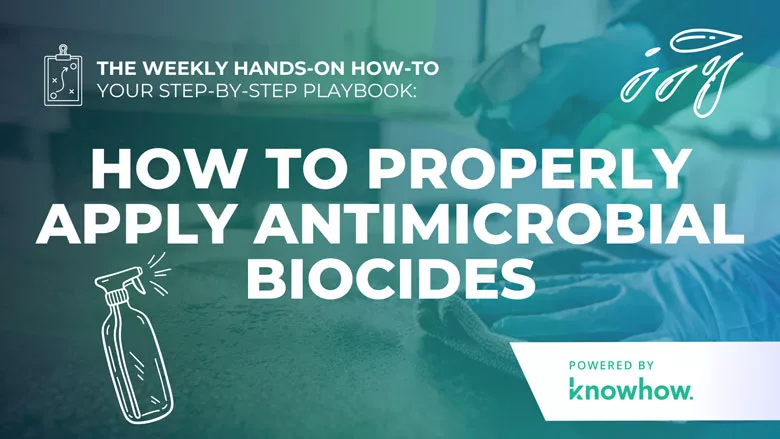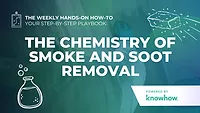Weekly Hands-on How-To powered by KnowHow
How to Properly Apply Antimicrobial Biocides
Effective Application of Antimicrobial Biocides in the Workplace

Bacteria, viruses, and fungi can thrive on contaminated surfaces, posing serious health risks and compromising the integrity of your work. That’s where antimicrobial biocides come in—they're essential for disinfecting and stopping microbe growth on surfaces and equipment. But using them effectively requires more than a quick spray-and-go approach.
Without proper preparation and application, dirt and organic matter can block biocides from reaching microbes, making the process ineffective. To ensure you’re thoroughly disinfecting surfaces, you need a clear, step-by-step approach that prepares the area and follows manufacturer instructions to a T.
In this how-to, powered by KnowHow, we’ll guide you through every step of the biocide application process, helping you safely and effectively reduce microbial risks. Let’s dive in and make sure nothing is left behind—except a properly disinfected surface!
Reminder: Proper Training is Required!
Before handling antimicrobial biocides, you and your team must be properly trained and certified through organizations like IICRC, NORMI, or other recognized industry bodies. These certifications ensure technicians understand proper application, safety protocols, and regulatory compliance.
Always follow industry best practices, work within your certification guidelines, and adhere to manufacturer instructions to ensure safe and effective biocide application.
Step 1: Clean the Surface
Before applying any biocide, it’s crucial to clean the surface thoroughly. Dirt, debris, and organic matter can shield microbes from coming into direct contact with the biocide, reducing its effectiveness. Use a detergent or soap with water, along with a clean cloth, brush, or scrub tool, to remove all visible contaminants.
This step lays the foundation for successful disinfection, ensuring that the biocide can reach and neutralize the microbes. Skipping this step can result in microbes surviving beneath layers of grime.
Step 2: Rinse the Surface
Once cleaned, the surface needs to be rinsed to remove any remaining detergent or soap residue. Residue left behind can interfere with the effectiveness of the biocide. Use clean water and a clean cloth to carefully wipe down the area, ensuring no soapy film is left.
This rinse prepares the surface for maximum biocide effectiveness by eliminating any potential barriers to contact.
Step 3: Apply the Biocide
With the surface prepped, it's time to apply the biocide. You can apply it using a spray bottle or, for smaller objects, immerse them fully in the solution. Pay close attention to the contact time required for the biocide to work—this is critical for ensuring that harmful microbes are fully neutralized.
Keep these key points in mind during application:
- Personal Safety: Wear gloves to protect your skin and wash your hands thoroughly after handling biocides.
- Surface Suitability: Biocides are designed for non-porous surfaces. Avoid using them on porous materials unless otherwise specified by the product manufacturer.
- Product Guidelines: Always follow the manufacturer’s instructions regarding concentration, application method, and contact time. Incorrect usage can reduce effectiveness and pose safety risks.
By following these steps, you ensure a thorough and effective disinfection process, mitigating the risk of microbial growth on treated surfaces.
Clean. Disinfect. Protect—with KnowHow
When it comes to applying antimicrobial biocides, preparation is everything. A surface that hasn’t been properly cleaned and rinsed can block the biocide from doing its job, leaving harmful microbes behind. But by following these steps, you can be confident that your disinfection process is thorough, effective, and safe.
And if you really want to stay ahead of safety and sanitation challenges, KnowHow makes it easy. With the simplest tools to build and manage SOPs and instant job site support, KnowHow ensures your team has the guidance they need—right when and where they need it. Stay sharp, stay compliant, and let KnowHow do the heavy lifting for your processes.
Ready to wipe out uncertainty and germs? Visit tryknowhow.com today and see how we can help keep your team and surfaces protected.
Looking for a reprint of this article?
From high-res PDFs to custom plaques, order your copy today!







